|
Subscribe / Renew |
|
|
Contact Us |
|
| ► Subscribe to our Free Weekly Newsletter | |
| home | Welcome, sign in or click here to subscribe. | login |
Architecture & Engineering
| |
December 6, 2000
Project of the Month: Research heaven at Harborview
Special to the Journal
Seattle has some great Art Deco buildings, according to MBT principal Peter Hockaday -- the Colman Building, the Exchange Building and Harborview Hospital -- to name three. So when his San-Francisco-based firm won the commission to design a new research center at Harborview, the architects didn't struggle long with the temptation to play counterpoint to the one of their favorite eras in design. Instead, they gave themselves over to a reinterpretation of the lines and expressive language of the early 20th-century style.
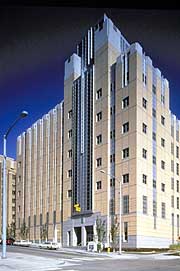
Photo by James Housel |
The new Harborview Research and Training Building now stands proudly with its historic counterpart.
It's Deco all right, but with a self-conscious flair that puts it squarely in the present. Complex tower forms, delicate grillwork and ribs, and well-defined piers accent the height. Contrasting brick tones and a generous number of windows give it human scale. The whole nine-story composition springs from its granite base with great vertical momentum.
The towering posture of the nine-story building follows naturally from the need to maximize use of the small 180-by-35-foot site prescribed by the master plan for Harborview. Five floors of labs were needed to meet the stated goal of maximizing new wet lab area at the medical center. And the building type requires ample space for ventilation and high ceilings, according to project manager Anthony Gianopoulos.
|
Project of the Month
Name: Harborview Research and Training Building Owner: University of Washington School of Medicine Architect: MBT Frank Tomsick, project principal; Tully Shelley, project principal; Ron Jewett, project designer; Anthony Gianopoulos, project manager; Kathleen Kelley, interior designer Associate architect: Miller/Hull Partnership Project type: Laboratory and conference facility Project size: 179,000 gross square feet Construction cost: $45 million Completion date: November 1999 Structural engineer: ABKJ Affiliate structural engineer Martens & Chan Mechanical engineer: Gayner Engineers Electrical engineer: Sparling Civil engineers: INCA Engineers Bush Roed & Hitchings Acoustic engineer: The Greenbusch Group Landscape architect: Osborn Pacific Group General contractor Robert P. McCleskey Jury Comments: "Showcases a limited palette of industrial materials ... lending it a distinctive and architecturally rich quality. The subtle integration of technology creates a provocative aesthetic, well suited to its function." |
The new research and training building is designed to be a strategic tool for recruitment in the highly competitive field of biomedical research. The facility includes research labs, support spaces, faculty offices and seminar rooms. The groups at work in the labs have grants for research in areas such as neurosurgery, trauma surgery and orthopedics. It also has a training and conference center with three classrooms, a 150-seat auditorium and a reception lobby.
Because of size of the floorplates and the space needs, there was no question of including a courtyard in the building, said Gianopoulos. Natural light and pleasant outward views would have to be achieved in some other way. Views of the medical center campus on the east and north, and dramatic views of Seattle and Mount Rainier to the south provided the raw material. Both off-street sides of the building are stepped in plan, providing even more daylight in the various common areas.
The designers made the most of these, providing sitting spaces and meeting on the north and south. The wide corridors, which are flooded with natural light from the full-height windows at either end, provide maximum visual awareness of the outside world and orientation within.
It's not a traditional laboratory building.
"When you think about research spaces you think about dark rooms in a basement," said Hockaday.
In the more conventional research facilities on large campuses like, for instance, the University of Washington, researchers work in individual offices arranged along long, double-loaded corridors in a vast complex.
"People get into funny, isolated situations," he said.
Each lab floor is designed to become a community of about 40 researchers. It is a flexible facility that is highly adaptable to specific needs, according to Gianopoulos. Cabinets can be moved and cantilevered lab tables can be raised and lowered. The entire building is fully wired, with data ports throughout. Power systems, which can be accessed through the closets of each floor, have 40 percent extra capacity to cover future needs in the facility.
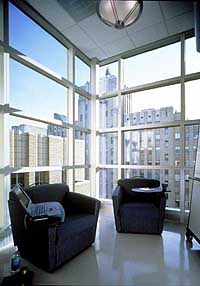
Photo by David Wakely |
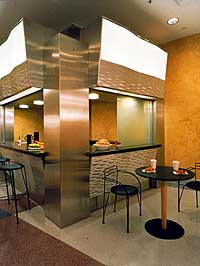
Photo by David Wakely |
In the new building, there is no chance of becoming isolated for days on end. In the middle of each floor, is a core space designed to hold shared equipment. As technology evolves, more and more of the repetitive tasks traditionally done by lab workers are now assigned to sophisticated -- and very expensive -- machines. Sharing makes sense from a practical standpoint. Support areas, where resources are located, are also places where researchers meet and mix on a regular basis.
"Learning to share equipment was part of the process of bringing people into the building," said Mike Robertson, manager of program operations there.
From the movable furniture in the small sitting areas at the ends of the halls, researchers can look out over the Harborview campus or the neighborhood. These chairs are well used, according to Robertson.
The tight footprint of the building and the sloping site meant that the architects had to stack the programmatic elements in a somewhat counterintuitive way. During lectures in the plush auditorium on the first floor, trucks rumble into the loading dock, which is just overhead on the second. But according to Robertson, there has been no hint of noise crossing the double ceiling of the first floor, designed with an acoustic layer and isolated lower layer.
Quiet on the training and conference floor extends to the smallest details. Doors are magnetic, so that they can be opened and shut without announcing new arrivals.
While the interiors of the building are functional and efficient on the upper floors, the first floor is designed to be inviting and comfortable. A streamlined Art Deco esthetic follows the design of the exterior into the expansive lobby and seating area. A metal grille representing the shapes of cells and other life forms, designed by artist Irene Pjoan, surrounds the main doors.
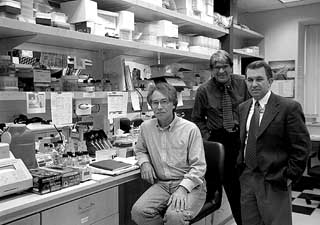
Photo by Clair Enlow |
Inside, a sculpted steel espresso bar with café seating welcomes visitors in the entry area. In the lobby, wood paneling and wainscoting with metal trim, specially designed light sources and colorful floor pattern contribute to a sense of arrival. The lobby opens into the sloped-floor auditorium. Several touches elevate the auditorium from a typical lecture hall. Rich, saturated colors in the carpet and upholstery embrace the audience. A padded bench is set into the back wall, providing a comfy perch for latecomers. Laptops can be plugged in at most seats.
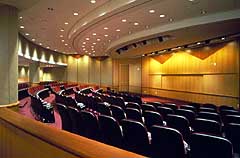
Photo by David Wakely |
"There's a lot of competition for space in here," said Robertson.
The Project of the Month feature is sponsored by the Daily Journal of Commerce and the Seattle chapter of the American Institute of Architects. Design categories include all types of construction, with the exception of single-family houses. Projects are selected by panel that includes distinguished architects, other members of the arts and design communities and representatives of client groups. The Project of the Month for December, the Harborview Research & Training Building, was selected with the assistance of architect Ron van der Veen, architect David Coleman and developer Dayna Dealy. For more information about submitting projects for possible feature articles, contact Peter Sackett at AIA Seattle, (206) 448-4938, or psackett@aiaseattle.org.
Clair Enlow can be reached by e-mail at clair@clairenlow.com.
Previous columns:
- Project of the Month: Setting the scene for serious entertainment, 11-01-2000
- Project of the Month: Fun follows function, 10-04-2000
- AIA Project of the Month: Mixing in the middle, 09-06-2000
- Project of the Month: A heart of blue, 08-02-2000
- One foot in the sky, 06-07-2000
- Project of the Month: Keeping company on Queen Anne, 05-03-2000
- Project of the Month: A livable law school at Seattle University, 03-01-2000
- Project of the Month: Old Ford plant gets a new engine, 02-02-2000


